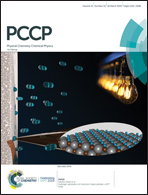Membrane pore formation and ion selectivity of the Ebola virus delta peptide†
Abstract
The Ebola virus (EBOV) is a filamentous lipid-enveloped virus that causes severe hemorrhagic fever with a high fatality rate in humans. The EBOV encodes a glycoprotein that when cleaved, produces the delta peptide. Experimental evidence suggests that the delta peptide functions as a viroporin that enhances virus particle release through the host cell membrane. However, the viroporin forming mechanism of the delta peptide is still not well understood. Guided by experimental information, we have computationally investigated the pore formation by different oligomers of the delta peptide. We have performed all-atom molecular dynamics (MD) simulations in an explicit membrane environment to investigate the pore-forming mechanism and stability of the pores. Our results suggest that the delta peptide forms stable pentameric pores. In addition, the pore is selective with respect to chloride ions, and the disulfide bond formed between Cys-29 and Cys-38 in the C-terminal of the peptide is essential for the pore stabilization and ion permeation. Our study provides helpful information on the pore-forming mechanism of filovirus delta peptides and such structural information can be important in designing and developing molecular modulators that target the delta peptide pore and disrupt the pathology of the Ebola virus.



 Please wait while we load your content...
Please wait while we load your content...